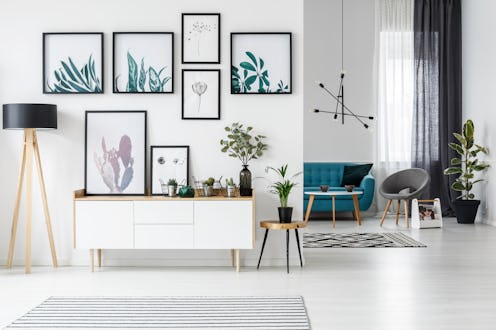(Living)
This Genius Pro Tip Will Make Painting Your Own Wall Art A Breeze

When it comes to decorating your walls, no trend is more timeless than the gallery wall. Whether you love photographs, concert posters, vinyl record album covers, paintings, or a mix of all of the above, putting together a wall full of beautiful art can really complete a space and make it feel homier. And while it's always nice to add completed pieces to your ever-growing art collection, buying art can be pretty expensive. That's why learning how to paint your own gallery wall art has become such a huge trend in the DIY community.
Even if you don't consider yourself artistically inclined, there are easy ways to create your own completely customized artwork to make your home feel more personalized. "Painting custom art for a gallery wall is a great way to add color and uniqueness to a room," says lifestyle blogger MaCenna Lee. "I love creating my own art as it's my stamp of uniqueness in each room of my home and I know no one else will ever have the same look."
Painting my gallery wall in my home office kept me occupied for a weekend of quarantine life in Los Angeles, and it has become one of my new favorite hobbies. There's something so therapeutic about being able to display work that I created on my walls, and when people are finally allowed to come visit my home, I know that the wall will be a huge point of pride. It might seem a little intimidating at first, but take it from someone who knows: Once you get started, you won't want to stop. Here are a few tips and tricks for DIY-ing your own gallery wall art.
DIY Wall Art Tip: Cohesiveness Will Play A Big Part In How Successful Your Wall Is
The most obvious way to make your paintings cohesive is to play on similar themes, like line work, abstract blobs, or anything else. But cohesion actually goes beyond just the subject matter of each painting. "Color plays a major role in cohesiveness," explains artist and illustrator Sabina Fenn. "Some colors are a match made in heaven, while others will change the whole mood and maybe veer it away from what you're going for."
She continues, "You can use websites such as Pinterest or Adobe Color to get some inspiration on color palettes that work. Once you have your color palette, making sure those colors are evenly distributed throughout the gallery will create balance and harmony."
Lee also advises picking one paint color that's incorporated throughout the gallery wall, whether it's a background in one, an accent detail in another, or the frame color of another.
DIY Wall Art Tip: Acrylic Paint Is The Easiest Medium To Start With
"If you're just getting into painting your own art, acrylic paint is a great medium to start with," says Lee. "[There are] loads of color options at an inexpensive price. What I love most is if you don't like how your painting is turning out, just paint over it with white acrylic and begin again." Fenn adds that acrylic works best on a canvas, and you can choose whether you prefer a stretched canvas or a flat one.
If you want to work up to working with watercolor paints, be wary that they're a little finicky. "Watercolor is a wild medium that does what it wants and it's very hard to correct mistakes when they happen," says Fenn. "With acrylic, you can paint over it very easily and you can also hide your pencil sketch much better."
DIY Wall Art Tip: Beginners Can Try Painting A Few Easy Shapes
For me, the easiest things to paint are abstract blobs. It's virtually impossible to mess them up because they're already meant to look uneven and random. If you do a collection of paintings with similarly colored abstract blobs on them, they'll automatically look cohesive and the paintings can be interpreted in so many different ways.
Lee painted smudged watercolor lines for the art in her kitchen, which is also relatively simple. Other options include splatter paint — which is so much fun — paint drips, and so much more. The sky really is the limit, so don't feel obligated to paint something super lifelike.
DIY Wall Art Tip: Make Sure Your Art Matches The Vibe Of Your Room
It probably sounds obvious, but the colors and themes you pick for your artwork should match the room they're going in. According to Fenn, the easiest way to do this is to take a couple colors from the existing decor in the room and incorporate those into your paintings.
You also want to pay attention to the mood of your room when you're painting. If you want the room to feel more playful and bright, pick themes that mirror that, like sharp geometric shapes in bright contrasting colors. For moodier, more mellow rooms, something more abstract and in a neutral color palette will probably work better.
Now that you have all of the tools you need to paint your own gallery wall, get to creating! And if you need to stock up on supplies, check out some of my recommendations below.
We only include products that have been independently selected by The Zoe Report's editorial team. However, we may receive a portion of sales if you purchase a product through a link in this article.
This article was originally published on